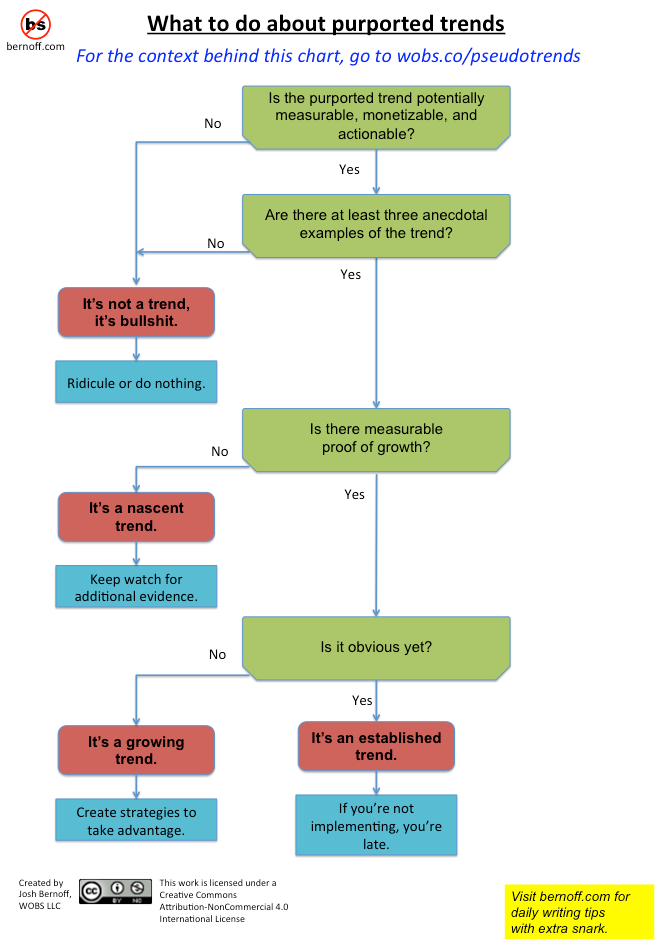Is it a trend or is it bullshit?
 Trends are hot. Jump on one soon and you may gain an advantage. But some of the “trends” you read about or hear about at industry conferences are hogwash. I’ll explain how to tell the difference and what to do about it.
Trends are hot. Jump on one soon and you may gain an advantage. But some of the “trends” you read about or hear about at industry conferences are hogwash. I’ll explain how to tell the difference and what to do about it.
Millennials aren’t having children! Police are predicting crimes before they happen! There’s a reason you see so many trend pieces. Businesses that act on trends get a jump on competitors. But the endless demand for new trends generates an explosion of trend predictions from industry analysts, pundits, authors and journalists all vying for your attention. Lots of those “trends” are bullshit — act on them and you’re wasting time or risking your company’s future.
To be smart about purported trends, assess them critically. Ask two questions:
- Is it a pseudotrend, or potentially real?
- What proof is there that the trend has traction?
The flowchart summarizing how to do this is at the end of the post.
Is it a pseudotrend, or potentially real?
Lots of what various trendspotters call “trends” are just a few random dots they’ve connected. These are pseudotrends: loose, amorphous patterns that you can’t define and can’t nail down. When you hear that doctors are grumpier these days, or YouTube is the new Hollywood, remember this:
[tweetthis twitter_handles=”@jbernoff”]A “trend” you can’t measure or disprove isn’t a trend, it’s bullshit. [/tweetthis]
Loosely defined pseudotrends are great for trendspotters, because these hucksters can just morph the trend definition to include any new data or examples they see. For the same reason, they’re bad for you because they’re too slippery to act on. To avoid becoming a pseudotrend victim, ask these questions:
- Could you potentially measure it? Researchers can verify a real trend with surveys or measurements. Pseudotrends are unmeasurable.
- Could anyone monetize it? Jeremiah Owyang makes a convincing case for the growth of the collaborative economy by measuring startup funding. If a trend falls into a market and doesn’t make a sound, it’s not actually there.
- Can you do anything about it? Assume the trend is true. What are you going to do differently about grumpy doctors? If nobody in business or government needs to act differently, then it’s not a trend, it’s bullshit.
What proof is there that the trend has traction?
After you’ve identified a potentially measurable, monetizable, actionable trend, you need to ask how far along it is. That will tell you what to do next. There must be some evidence, even it’s not numerical.
- Is the evidence anecdotal? Gather more before acting. Journalists like to write articles about a couple of people doing something — like teenagers putting Burt’s Bees on their eyelids, or companies dumping email. Unless you can cite at least three examples, it’s a fantasy. Head-mounted wearables is not trend, it’s a product from Google. But connected home devices (Nest Thermostat, Philips Hue Lighting, August Smart Door Locks) is a nascent trend. Here’s what to do about nascent trends with anecdotal evidence: keep an eye out for more evidence or data. Acting on such trends is exciting, but risky.
- Is there quantitative evidence of growth? Prepare strategies. Researchers can measure growth with tools like consumer surveys, business surveys, and industry revenue metrics. Take companies delivering services on cloud platforms like Amazon Web Services — you can measure the growth there. One data point is interesting. Two shows growth, at least potentially. More than two is a trend. If such a trend creates opportunities and threats to your business, you’d better get a strategy. (Industry analyst firms like Forrester prove their value by measuring these trends and supplying strategies for them.)
- Is the growth obvious? Focus on implementation. Smartphones? Facebook use? These are established trends. Stop planning and act, now. Smart companies facing a trend this far along are creating products and services or implementing strategies, not just planning.
Here’s a flowchart that summarizes what to do.

Agree! A huge problem with trends is that they lack foundation but an even bigger problem is that they are too often blatantly obvious to the point of being useless. For example I just read a post about “top trends for 2016” recently where the first one was about how “online video is exploding.” While technically true, I don’t believe that’s really a trend. It is simply a statement of reality. So what you call an “established trend” is, I believe, something of an oxymoron. Trends, by their nature, should enable us to look around the corner to the future. They should describe the accelerating present but NOT be totally obvious. Otherwise they are not particularly innovative and have limited value as a result.